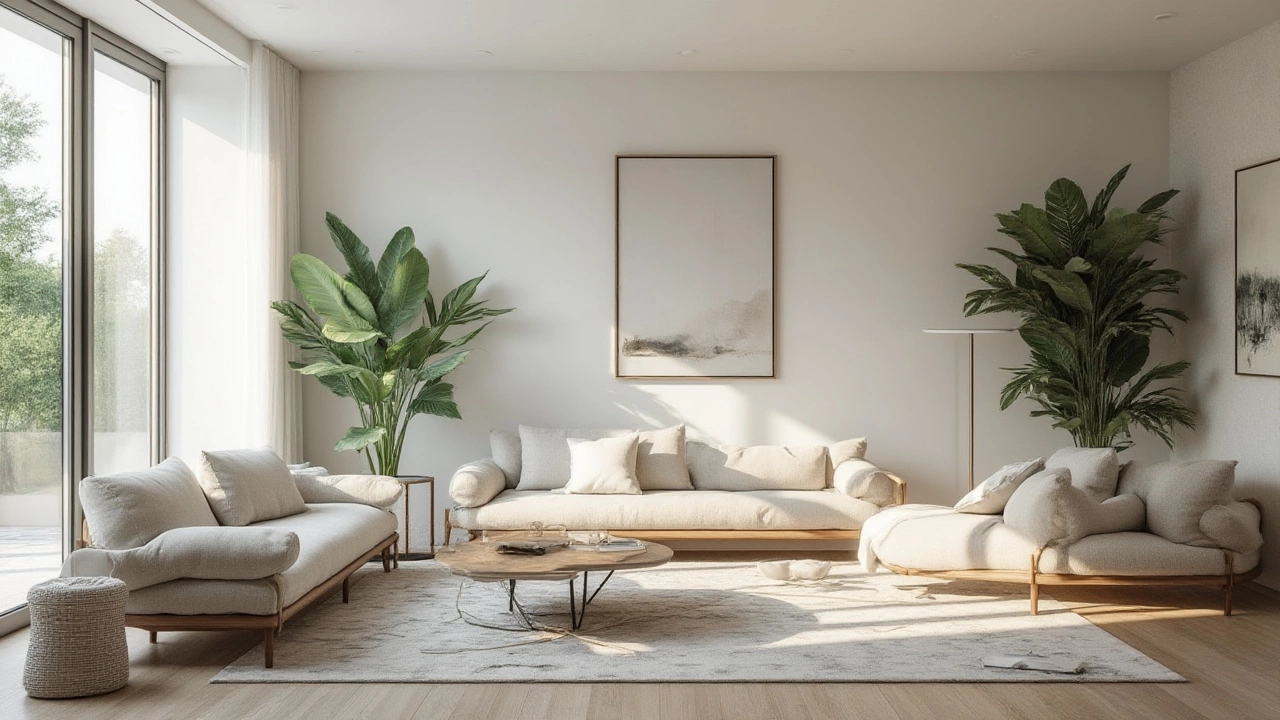If you’ve ever found yourself scrolling through Instagram or Pinterest, pausing at chic living rooms and kitchens with those clean lines and clever pops of color, you might wonder—how do people pull off that modern interior look in real life? Believe it or not, it’s not just reserved for millionaires or professional designers. Modern style is all about smart choices, simplicity, and mixing function with beauty. Whether you live in a downtown loft or a cozy family house in the suburbs, updating your space for a fresh, modern feel is within reach.
Understanding Modern Interior Design
Before you start moving furniture or shopping for new pieces, let’s talk about what "modern" really means—because, honestly, there’s a lot of confusion between modern, contemporary, and even minimalist. Modern design generally refers to a movement that took off in the early-to-mid 20th century. Think of those iconic Eames chairs or the classic Barcelona lounger: less ornament, more function, and a love of clean lines. Modern design favors open spaces, natural light, and uncluttered surfaces. It values materials like wood, glass, polished metal, and neutral color palettes with the occasional strategic color burst.
What’s so appealing about this style? For starters, it makes small rooms feel bigger and gives messy spaces a calming, organized personality. Studies have shown that a clutter-free environment can cut down on daily stress—no joke, scientists at UCLA tracked families and found that houses with less clutter helped homeowners relax. Modern isn’t about ripping out every cozy touch though. It’s the art of balancing “less-is-more” with real-life comfort. That’s why a true modern home doesn’t look like a sterile office. It should be easy, crisp, and inviting—like a favorite little black dress or sharp suit you keep reaching for.
Choosing a Modern Color Scheme
Colors set the entire mood for your rooms, so nailing your palette is half the battle. Modern interiors usually stick with neutrals—think white, gray, blacks, beige. Why? Soft neutrals visually expand any space and let architectural details shine instead of shouting over them. For example, if you paint your walls a bright, chilly white like Benjamin Moore’s “Chantilly Lace,” the whole place can feel airier and more current. Add in some black or deep charcoal for contrast—maybe in window frames or light fixtures. The subtle play of light and dark makes everything sharper without feeling cold.
But modern doesn’t mean colorless. You can—and should—add a punch of color in strategic spots. Maybe it’s a sapphire blue velvet couch, a butter-yellow lounge chair, or vivid cushions. Even a statement plant counts (fiddle leaf figs are timelessly popular). The trick is not to go overboard. Just like an art gallery uses a white backdrop to make the artwork pop, your limited use of bold hues will stand out more against a calm background. Paint companies now report that “greige” (a warm gray-beige mix) is one of the best-selling modern colors for living rooms because it’s so flexible and forgiving.
Consider how your choices affect natural light too. A matte finish helps avoid glare in sunlit rooms and warms up all the hard lines and glass. Don’t forget the fifth wall—the ceiling. Painting it two shades lighter than your walls or using a barely-there pastel can make ceilings soar. If you’re tempted to go for wallpaper, lean toward geometric or abstract patterns in muted tones—these mesh well with modern styles and don’t dominate the view.

Modern Furniture and Layout Tricks
Furniture really makes or breaks a modern interior, and here’s where most people get tripped up. Rule of thumb: invest in a few key, fantastic pieces, rather than crowding your room with lots of small, mismatched items. Modern furniture has simple shapes, neat lines, and slim legs. Low-profile sofas, open bookshelves, and sleek sideboards keep the space feeling light. Glass coffee tables, for example, almost disappear from sight but still do their job, making the whole room look bigger.
Multi-functional furniture is all the rage in modern homes, especially if you’re tight on space. Ottomans with hidden storage, fold-out desks, or modular sofas let you change the layout as your needs shift. A survey from the American Home Furnishings Alliance in 2023 found that 57% of city dwellers now look for "transformer" furniture when shopping for apartments. So, yes, you can be both practical and stylish.
The layout itself matters just as much as the pieces. Ditch the instinct to shuffle everything against the walls—sometimes, floating your furniture in the middle creates a cosier nook or conversation zone. Keep clear walkways (at least 30 inches between big pieces), and think about the view from room to room. Open-plan living areas are common in modern homes, but if yours is more traditional, use rugs and low shelves to visually break up zones for lounging, dining, or working. Add a pair of matching floor lamps at each end of a sofa for symmetry—a good trick that designers swear by to eye-balance any space.
If you love vintage markets, hunt for mid-century modern icons—they’re always in demand for a reason. The right statement chair or retro sideboard can update an entire room without new paint or wallpaper. But don’t venture too far into the “retro diner” look; mix old and new for a layered but unified vibe. And keep surfaces mostly clear—your coffee table isn’t a storage bin. A single sculptural piece, like a chunky travertine bowl or a bold, modern vase, is enough to leave an impact.
Lighting: The Secret Ingredient
No matter how sharp your furniture and colors are, bad lighting can ruin the effect. If there’s one place to splurge in your modern update, choose lighting. Designers always say, "Lighting is the jewelry of the room." It ties everything together and highlights what you want to show off. Modern interiors go for natural light first, so ditch heavy drapes for sheer curtains or blinds you can tuck away. Natural light boosts mood and even helps reduce energy use.
Overhead fixtures matter too. Swap dated chandeliers or those “boob” lights (everyone knows them) for a modern pendant or a row of LED track lights. LEDs have come a long way in the last few years—they last longer, use less energy, and you can pick the exact shade of white you want (go for "soft white" for a natural, welcoming glow). Table lamps and floor lamps in metal, glass, or matte black help build layers of light. Point them toward walls or up at ceilings for a diffuse, cozy effect. Smart bulbs are a gamer-changer, letting you control brightness or color temperature with your phone—so easy.
If you’re the kind of person who can’t stand fiddling with dozen switches and remotes, opt for dimmers. This simple upgrade can change the whole vibe from “Monday morning” to “Saturday night” in seconds. And one more hack: put small LED pucks or strips inside bookshelves and cabinets. Suddenly, your display looks gallery-ready—at a fraction of the cost of custom lighting.
Data from Statista in late 2024 showed that about 41% of US homeowners planned to upgrade their lighting as part of a modern interior refresh. The market for smart lighting alone is expected to hit $18 billion globally by 2026—a clear sign people are catching on to the power of good light.

Smart Styling and Finishing Touches
With furniture, color, and lighting in place, the final step is what I call “finishing magic.” How do designers make those magazine homes look lived-in, not showroom stiff? It’s all about curation and restraint. Don’t fill shelves with everything you own. Choose a few favorite books, a ceramic bowl, or a simple framed print. Go for larger statement pieces over little knick-knacks—less dusting, more wow.
Plants are a must. Even a simple monstera in a clay pot adds life and energy to a space. If you’re short on green thumbs, snake plants and pothos are practically indestructible. In fact, NASA researchers found that houseplants can boost indoor air quality—and yes, it’s still true, even though their 1989 study has made the rounds for decades. Add different textures to keep your space from feeling flat. Combine sleek surfaces like glass or metal with plush throws, chunky rugs, or natural wood bowls. Mixing textures gives depth without clutter.
On the art front, go big or go simple. A single oversized canvas or a grid of smaller black and white photographs immediately looks deliberate and smart. Skip the small frames spread randomly around; aim for symmetry and clean lines. Frame art with narrow, matte-finish edges in black, white, or natural oak to lock in the modern feel. Baskets, trays, and unique bowls corral remotes, cables, and odds-and-ends—a subtle nod to order. Modern interior style is as much about what you leave out as what you display.
Don’t forget these quick wins:
- Switch out old outlet covers and door handles for matte black or brushed metal—an instant style upgrade.
- Use stackable, clear bins in closets and cabinets to keep clutter hidden and easy to find.
- Cover dated flooring with a big, bold area rug in geometric or abstract patterns. It works wonders for renters.
- Hide cables and cords inside fabric sleeves or snap-on covers for a sleeker look—no more tech spaghetti on display.
And a quick stat: According to a National Association of Realtors report in 2024, 73% of buyers said that a modern, uncluttered look made homes feel more spacious and welcoming during tours—so your makeover might even pay off later.
| Feature | % Homeowners Wanting |
|---|---|
| Open Floor Plan | 68% |
| Large Windows/Natural Light | 59% |
| Minimalist Decor | 56% |
| Smart Lighting | 41% |
| Multi-purpose Furniture | 38% |
Modern isn’t just a look—it’s a mindset. Every style update you make is a nudge toward a space that feels calmer, more inviting, and totally right now. So, next time you walk into your place, ask yourself: Does it give you that contented sigh, or is it still stuck in the past? With the right mix of choices, any home can go modern—no degree in design needed.


